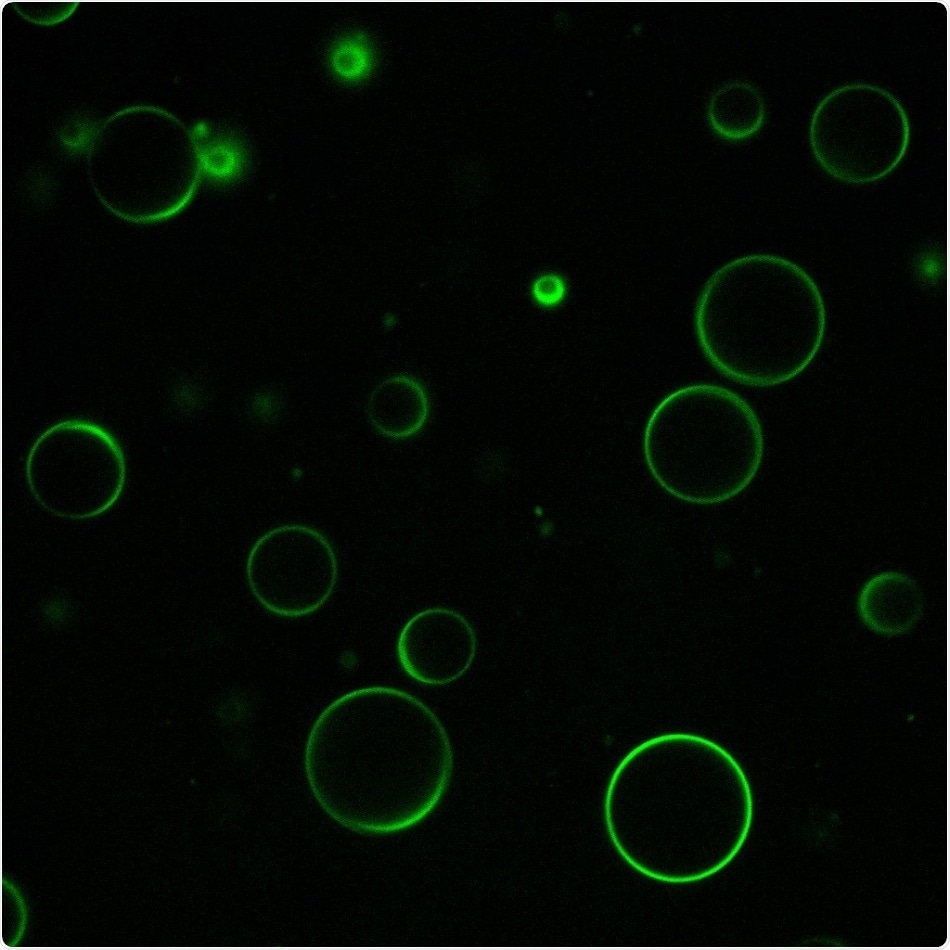Researchers have produced spherical and hollow sacks called vesicles using RNA and protein.

A fluorescence microscopy image shows protein-RNA vesicles created in the lab. The vesicles—hollow, spherical sacks—were made without traditional lipid building blocks. Image Credit: Ibraheem Alshareedah.
Vesicles are bubble-like entities—which form abruptly when particular RNA and protein molecules are combined in an aqueous buffer solution—show promise as biological storage compartments.
According to the researchers, vesicles could act as an alternative to standard vesicles that are produced from water-insoluble organic compounds, known as lipids.
Our discovery has widespread implications, from understanding basic cell biology to enabling possible biotechnological applications, such as targeted drug delivery or pesticide release.”
Priya Banerjee, PhD, Assistant Professor, Department of Physics, College of Arts and Sciences, University at Buffalo
Priya Banerjee continued, “These hollow spheres look and behave like the classical lipid vesicles that people have been utilizing in bioengineering applications for many years, with an important exception: They are not made by lipids.”
Because of the hollow structure resembling lipid vesicles, one may envision a potentially exciting application where protein-RNA vesicles are dispatched into cells for carrying out rescue missions by releasing biomolecules or changing the local subcellular environment.”
Davit Potoyan, PhD, Assistant Professor, Department of Chemistry, Iowa State University
Davit Potoyan continued, “Another reason to be excited is that these vesicles are formed spontaneously from naturally occurring proteins and nucleic acids, which may help to avoid issues of toxicity that might be seen in other polymers designed to mimic lipid vesicles.”
The study results were published in the Proceedings of the National Academy of Sciences on June 22nd, 2020.
Both Banerjee and Potoyan headed the study, in association with Ibraheem Alshareedah, a physics PhD student from the University at Buffalo, and Mahdi Muhammad Moosa, PhD, a physics postdoctoral scholar, also from the University at Buffalo, who performed the experiments, and Muralikrishna Raju, PhD, a chemistry postdoctoral scholar from Iowa State University who conducted computer simulations.
The researchers created the micron-sized vesicles by combining RNA with naturally occurring cationic proteins in an aqueous buffer solution. At certain concentrations, the RNA and protein molecules combined together to create liquid droplets, similar to beads of oil floating in water. However, at other concentrations, the RNA and protein instead clustered together to create the bubble-like vesicles.
As part of the study, the researchers also plotted the conditions under which every type of structure forms. Simulations and experiments demonstrated that the protein-RNA complexes combine spontaneously and are held together due to chain entropy, weak electrostatic attraction, and repulsive interactions. A fragile balance of these forces decides whether hollow vesicles or liquid droplets will form, stated the scientists.
We argue that there is a tradeoff between these forces. When you have too much repulsion, the protein and RNA molecules stay separated. But when you balance these intricate forces, you see a stabilization of these different structures, liquid droplets or hollow condensates.”
Priya Banerjee, PhD, Assistant Professor, Department of Physics, College of Arts and Sciences, University at Buffalo
After finding the principle of the formation of vesicles, the researchers produced analogous hollow droplets using other building blocks, like synthetic polymers and designed polypeptides, proving that the findings may have wide applications.
Mahdi Muhammad Moosa stated, “We also observed that similar lipid-free vesicles can form with many proteins and RNA mimetics. The ability to pick and choose from a large pool of mimetics will allow customizable biotechnological application of these assemblies.”
The University at Buffalo has currently filed a provisional patent application for the lipid-free protein-RNA vesicles as well as the techniques for making the vesicles.
The recent work resulted from Banerjee’s previous study on protein-RNA complexes, which targeted the generation of liquid droplets from RNA and protein molecules.
In one experiment, “When we added more RNA to the droplets, immediately these compartments, these beautiful bubble-like structures, started forming inside those droplets. But it wasn't stable, and it went away in a few minutes,” recalled Banerjee.
That peculiar observation guided Banerjee’s team to initiate a research on ways to produce the hollow structures and protect them for longer periods of time, which was achieved by the new study. The study on hollow droplets as well as liquid may offer a better understanding of how analogous compartments form suddenly within human cells, Banerjee explained.
According to the scientists, one interesting aspect of the study is the formation of vesicular geometry, which is reminiscent of membranes, emerging from both protein and RNA molecules.
It is well known that lipids are the building blocks for biological membranes; however, the latest study indicates that other possibilities may be available for producing membrane-like barriers in biological systems that were not known before, concluded Banerjee.
Upcoming studies could analyze whether and how protein-RNA membranes can be used by cells to carry out specific biological functions.
Source:
Journal reference:
Alshareedah, I., et al. (2020) Phase transition of RNA-protein complexes into ordered hollow condensates. Proceedings of the National Academy of Sciences. doi.org/10.1073/pnas.1922365117.